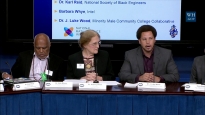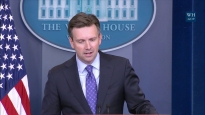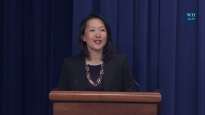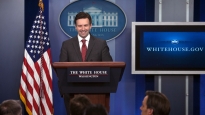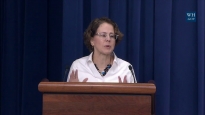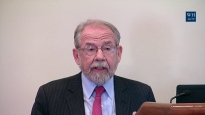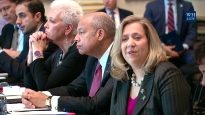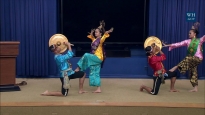Press Briefing 5/13/09
May 13, 2009 | 41:57
White House Press Briefings are conducted most weekdays from the James S. Brady Press Briefing Room in the West Wing. (public domain)
Download mp3 (38.5MB)
Press Briefing by Press Secretary Robert Gibbs, 5/13/2009
THE WHITE HOUSE
Office of the Press Secretary
____________________________________________________
For Immediate Release May 13, 2009
____________________________________________________
For Immediate Release May 13, 2009
PRESS BRIEFING BY
PRESS SECRETARY ROBERT GIBBS
PRESS SECRETARY ROBERT GIBBS
James S. Brady Press Briefing Room
2:05 P.M. EDT
MR. GIBBS: I want to do two things before we formally get started -- first of all, a statement on the confirmation of the newest Administrator of FEMA.
The President appreciates the good work of Acting FEMA Administrator Nancy Ward, but is pleased his nominee, Craig Fugate, was confirmed last night by unanimous consent. From his experience as a first responder to his strong leadership as Florida's Emergency Manager, Administrator Fugate has what it takes to ensure America is ready to respond to an emergency. He will be a tremendous asset to FEMA, its employees, and the American people.
Secondly, I just want to give you guys a quick readout from the President on his meeting today with Senate leadership and members of the Judiciary Committee.
The President met with Senate leaders Reid and McConnell, as well as the leaders of the Senate Judiciary Committee, today in the Oval Office. The meeting lasted approximately 40 minutes. The President made clear that he welcomed consultation during the nomination and confirmation process. He reiterated that he would choose a nominee who respects the Constitution and judicial precedent and also has the good judgment and common sense to reach fair decisions.
The President encouraged the senators to move expeditiously during the confirmation process to ensure that the next justice be ready to serve when the Court's term begins in October with time to prepare beforehand. There was agreement that the process would be civil and allow the nominee to get a fair hearing in which their views could be thoughtfully discussed in a way that highlights the strengths of the American justice system.
And with that, Mr. Babington.
Q Robert, regarding the photos of detainees in Afghanistan and Iraq, you took several questions on this on April 24. You said that it was that DOJ decided it was hopeless to appeal and the administration had entered into an agreement to release the photos. You got a question about whether the President was concerned about if the release might do harm to our troops, and you said his decision was consistent with his goal of keeping the nation and the troops safe. And you said that this is among the many actions that are out of our control.
So my question is what has changed to make you think that you have more control, and what has changed about the concerns about the harm to the troops?
MR. GIBBS: Well, Chuck, as I said yesterday, the President was concerned about harm to the troops. I think part of my answer in that briefing also was a question about whether or not this was likely to impact our legislative agenda.
The President, as you all know, met with his legal team last week because he did not feel comfortable with the release of the photos; primarily believes that -- and I'll go through some of the dates in the court that I did yesterday. This all stems from a FOIA -- first from detainee abuse investigations that were concluded by the end of 2004. There was a FOIA case that started -- the first ruling was in September of 2008. That ruling was appealed I believe in December of 2008. On March 11th, the Second Circuit declined to have the full circuit review the three-judge ruling appealing the decision that was made.
The President does not believe that the strongest case regarding the release of these photos was presented to the court, and that was a case based on his concern of what the release of these would do to our national security. He believes that the release of these photos could pose a threat to the men and women we have in harm's way in Iraq and Afghanistan, and doesn't believe that we made -- doesn't believe that the government made the strongest case possible to the court and asked the legal team to go make that case.
Q But what changed to -- you're just stating now that he is concerned that it would do harm, but --
MR. GIBBS: I'm not stating that now. I believe I've always stated that and I stated it as well yesterday.
Q On the 24th you stated the opposite, that he had come to the conclusion that this would not cause harm to the troops.
MR. GIBBS: I will go back and -- I looked at part of that a few days ago. I have not seen the full -- but I'll be happy to take a look at it.
Q The question is, are you concerned that it would cause a backlash against our troops in harm's way? You said that the President has done a lot of back-and-forth in his mind over the course of several weeks about ensuring that this protected those who keep us safe, that it protected our national security. The President came to a determination that the decision that he made was consistent with all those criteria.
MR. GIBBS: Well, the President reflected on this case and believes that they have the potential to pose harm to our troops.
Q Was he pressured by the military?
MR. GIBBS: No. In fact, this was brought up -- his decision was brought up with General Odierno yesterday at the end of their meeting, the meeting that General Odierno and Ambassador Hill had with the President. The President brought this up at the end of the meeting to inform General Odierno of his decision.
Obviously, there has been concern. There was certainly concern throughout the process by folks that -- the harm that could be caused by the release.
Q Did they make it known to him?
MR. GIBBS: I think they have. But I would also say the President believes a couple of other things. Understand that the existence of these investigations are -- and I don't know the exact address, but they're on the DOD website. The President believes that the release of these photos will also provide a disincentive for detainee abuse investigation.
The photos don't denote the existence of the investigations -- they're simply part of the potential evidence in the cases that have been finished since 2004. But if in each of these instances somebody looking into detainee abuse takes evidentiary photos in a case that's eventually concluded, this could provide a tremendous disincentive to take those photos and investigate that abuse. I would also add, lastly --
Q Wait, try that once again. I don't follow you. Where's the disincentive?
MR. GIBBS: The disincentive is in the notion that every time one of these photos is taken, that it's going to be released. Nothing is added by the release of the photo, right? The existence of the investigation is not increased because of the release of the photo; it's just to provide, in some ways, a sensationalistic portion of that investigation.
These are all investigations that were undertaken by the Pentagon and have been concluded. I think if every time somebody took a picture of detainee abuse, if every time that -- if any time any of those pictures were mandatorily going to be necessarily released, despite the fact that they were being investigated, I think that would provide a disincentive to take those pictures and investigate.
Q How do you square this -- you use the term "sensationalistic." But how do you square that with your frequent comments about greater transparency? That seems completely at odds.
MR. GIBBS: No, Chuck, again, the existence of the detainee abuse cases is not denoted by the photos. They're evidence contained -- or evidence as part of those investigations. The existence of the cases are on the websites, they're on the DOD website. Okay? So the notion that somehow you don't know about these investigations because you haven't seen the photos doesn't make any sense.
Q Right, but you agree that you should allow photos, for example, of the troops that were killed in action coming back to Dover Air Force Base.
MR. GIBBS: No, again, let's be precise. The President and the Secretary left it up to those involved in those cases for families to determine whether or not they wanted to make the ceremony open to the press or not.
Q The point I'm trying to make is that you have -- you're saying -- you have acknowledged that the existence of photographs can be a compelling component of understanding what's going on in any given situation, and in the name of transparency it seems like it would apply here.
MR. GIBBS: The President doesn't believe that the release of these photos adds in any way to that. It only adds to pose harm.
Q Robert, can you go over the sequence of events that led to his thought process? Because on April 24th, when the Pentagon was explaining its decision to release the photos, it said that -- the spokesman said that there was a feeling that the case has pretty much run its course. And now you're saying that the President feels that there's a strong argument to be made --
MR. GIBBS: Because the argument that the President has asked his legal team to make is not an argument that the previous legal team made in that case. They argued a couple of different things including a law enforcement exception, and a judge ruled that to seek a law enforcement exception you have to disclose the name of the person that would be -- that harm would be derived for in seeking that exception. This is a different argument that the President thinks is compelling.
Q When did you decide that it was important to make that argument? Did one of the lawyers come to him and say --
MR. GIBBS: No, he came to the lawyers.
Q And when did all of that take place?
MR. GIBBS: That was a meeting that was held last week in the Oval Office.
Q Robert, if that was such a compelling case why was that not weighed in April then? Because it seems like -- was there a failure here at the White House in the first go-round in April to fully weigh the national security implications?
MR. GIBBS: The argument that the President seeks to make is one that hasn't been made before. I'm not going to get into blame for this or that, understanding that there was significant legal momentum in these cases prior to the President entering into office. We are now at a point where it is likely that some stay will be asked to prevent the release of these photos. And I believe the date, that we have until June 8th to appeal -- to seek review of the decision by the Second Circuit.
Q Well, on April 24th, you also said, the Department of Justice decided based on the ruling, the court ruling, that it was "hopeless to appeal." Now you're saying it's not hopeless.
MR. GIBBS: Well, based on the argument that -- yes, I said that it was hopeless based on the argument that was made during the course of the original FOIA lawsuit, the appeal, the three-judge ruling and the decision to decline the full circuit to make that -- to make those determinations.
The President isn't -- what I'm saying to you, Ed, is the President isn't going back to remake the argument that has been made. The President is going -- has asked his legal team to go back and make a new argument based on national security.
Q This new argument -- if you're saying basically that this could put troops in further harm's way in Iraq and Afghanistan -- former Vice President Cheney, General Hayden, others have made the same argument about releasing the so-called torture memos. Do you have any regrets about putting those memos out --
MR. GIBBS: No --
Q They've made the same argument about them.
MR. GIBBS: Well, I'll use the example I've used on this before, Ed. You didn't begin to report on enhanced interrogation techniques at the release of the OLC memos, did you?
Q No.
MR. GIBBS: Okay. I'm sensing --
Q But you all are saying --
MR. GIBBS: Hold on. I'm also sensing that the graphic that CNN uses to denote what happens when somebody gets waterboarded wasn't likely developed based on reading memos that were released three weeks ago. The existence of enhanced interrogation techniques were noted by the former administration in speeches that they gave. You read about the enhanced interrogation techniques in autobiographies written by members of that former administration. The notion that --
Q So by that argument, our graphics would not also be based on any prisoner photos you might release because we already know that people we're abused in prisons. So why not put them out there --
MR. GIBBS: I'm not sure that you'd do a graphic of a photo.
Q Well, a graphic of someone being abused. We all have seen the Abu Ghraib photos. And you were saying about the photos back in April, look, it's already exhausted and essentially these photos are going to come out anyway.
MR. GIBBS: Based on the previous legal argument, yes. The previous legal argument denoted that the case had been lost. There's a new legal argument that's being made.
But my sense is, Ed, why do you do a graphic on CNN?
Q We're trying to show people what -- explain to people what --
MR. GIBBS: Okay. The President believes that the existence of the photos themselves doesn't actually add to the understanding that detainee abuse happened, was investigated, that actions were taken by those that did indeed or might have undertaken potential abuse of detainees, and that those cases were all dating back to finishing in 2004. The President doesn't believe the release of photos surrounding that investigation does anything to illuminate the existence of that investigation, only to provide some portion of sensationalism.
Q But, Robert, is that really his role to decide whether or not it illuminates? That's not the President of the United States' role to decide, well, this information will illuminate for the people and this information isn't --
MR. GIBBS: No, the role of the President in this situation is as Commander-in-Chief, and if he determines that through the release of these photos that they pose a threat to those that serve to protect our freedom in Iraq and Afghanistan through the illumination of whatever, he can make a determination to ask his legal team to go back to court and make a legal argument that he doesn't believe was made and provides the most salient case and most important points for not releasing these photos. Those determinations are indeed made by this President and are being made.
(Cell phone rings.) Just put in on vibrate, man, we did this before. (Laughter.)
Q I'm sorry.
MR. GIBBS: That's all right. It's all right.
Q -- time it happened.
MR. GIBBS: Third, actually. It happened twice that one day.
Go ahead.
Q The Bush administration has obviously made the argument that releasing these specific photographs will endanger troops and they did so in a way that he described with -- while seeking the FOIA exemption for law enforcement personnel. The Second Circuit Court ruled against that, saying that it's not -- that exemption is not intended "as an all-purpose damper on global controversy." What is this new argument that the President wants his team to present?
MR. GIBBS: That not seeking an exemption for law enforcement -- (cell phone rings.) Give me the phone. (Laughter.) All right. This is -- come here. Let me see this. (Laughter and applause.) This is enhanced interrogation technique. (Laughter.)
Q He threw your phone.
MR. GIBBS: No, no, somebody caught it, no worries. (Laughter.) I made the determination that -- (laughter) -- the illumination of the sound was distracting to the briefing as the Press Secretary to the President of the United States.
Q Here's that mallet you wanted. (Laughter.)
(Cell phone rings.) (Laughter.)
MR. GIBBS: You, too? You want to do this, too? Here, come on. (Laughter.)
Q Gibbs wants to take my phone, but I don't think it's a good idea. (Laughter.)
Q No favoritism.
Q I'll explain later. (Laughter.)
MR. GIBBS: I assume it's your banker, with a suit like that. (Laughter.) Sorry. This is -- cotton candy down the street, it's a circus.
The President believes that the specific case surrounding the damage that would be done to our troops and our national security has not fully been developed and put in front of the court to make. That's the case that the legal team will now make. The Department of Justice will seek to look for different avenues; as I said earlier, likely seek a stay.
Q With the Supreme Court?
MR. GIBBS: Well, you could seek a stay with an additional judge. The June 8 deadline also is for an appeal to the Supreme Court, and that's likely the next -- (cell phone rings.) Golly, guys. Just put them on vibrate.
Yes, go ahead.
Q The specific avenue that your legal team is going to go, you're not sure if it's going to be going back to the District Court?
MR. GIBBS: I don't know. I'll check with -- we'll check with those guys specifically. I think in some ways they're looking at whether it is to go to a lower court, or to go to the Supreme Court.
Q And then just to follow up on the new argument. So are there specific -- is there specific case law arguments that the President knows that exist that were not used? Because I find it hard to believe that the Bush administration didn't turn under every rock to try and find an argument --
MR. GIBBS: Well, the President doesn't believe that was the case. And the President, after reviewing the case, believes that we have a compelling argument.
Q Could you let us know what those new arguments are?
MR. GIBBS: Yes.
Q Thank you.
Q Is part of his concern here, though, that this would open the flood gates for new calls for an investigation? And what does this mean for his stance on whether more memos should be released and that type of thing?
MR. GIBBS: Well, I'm not sure that this case is necessarily analogous and I wouldn't want to draw broad conclusions not based on some specificity.
Q What is his current stance on whether there should be an investigation?
MR. GIBBS: Well, I think we covered that a few weeks ago.
Q We covered it, but --
MR. GIBBS: Well, I should say that it hasn't changed since we last covered it.
Q He's sort of gone back and forth on that issue. I mean, he sort of left the door open to it, but then you've signaled --
MR. GIBBS: No, no, no. We'll do this again. The President believes that the determination about whether or not anybody broke the law should be made by those who determine whether or not anybody broke the law, and that, in this case, would be the Department of Justice.
Q But should there be any kind of congressional panel looking into this? At one stage, you raised the idea of a 9/11 type of --
MR. GIBBS: Yes, I think the President -- and I have said this before -- the President believes a lot of this is being investigated by the Senate Intelligence Committee; that that's an avenue and a venue that possesses, because of clearances and such, a broad ability to conduct an investigation, and he thinks that an appropriate place for it to be.
Yes, sir.
Q On the argument that this would -- that release of the photos would be a disincentive into investigations, wouldn't it also be a disincentive into detainee abuse? And on those investigations, we don't -- if they're administrative rather than judicial, we don't know the outcome of a lot of those investigations.
MR. GIBBS: On the first part -- I can certainly check with Pentagon on part two. Look, I think you could certainly argue that it hasn't always been the case, because obviously there continue to be cases, regrettably, of detainee abuse. But at the same time, if each and every photo that is taken, regardless of whether that -- regardless of the fact that it doesn't actually add to the notion that these cases are being looked into, the President believes provides that disincentive.
On behalf of CBS, Mark. You're now the sole representative for the --
Q Let me get my cell phone out. (Laughter.)
MR. GIBBS: Yes, exactly. You want to phone it in? (Laughter.)
Q How was this decision on the photos consistent with what he said on his second day in office: "I will hold myself, as President, to a new standard of openness. Information will not be withheld just because I say so."
MR. GIBBS: Look at that. I got a "hmm." Because, Mark, the President has, in this case -- welcome back.
Q What did I miss? (Laughter.)
Q There was a call for you. (Laughter.)
MR. GIBBS: Will somebody brief Bill on the new Supreme Court nominee. (Laughter.)
Because, again, the President -- as I said to Jake's question, the President made this determination as the Commander-in-Chief; made this determination as somebody who is charged with protecting our men and women in harm's way. That's why this determination was made. That's why he's asked the legal team to go back to court.
Q And his statement is for civilian matters, and not for national security matters?
MR. GIBBS: No. I think, again, Mark, as I said, I don't think the -- the existence of the photos doesn't denote -- isn't the only thing that denotes the existence of an investigation. The website includes documentation that underscores the potential abuse that was being investigated through the year 2004. The President doesn't believe that the existence publically of the photos adds to that.
Q I want to change topics for just I'm sure what will be a brief moment. (Laughter.)
MR. GIBBS: Thirty seconds to respond. No, I'm kidding.
Q Former SEC Chairman Arthur Levitt today said that when it comes to the government imposing executive compensation restrictions across all -- the whole financial services industry, that it can't work, it won't work, and that the government shouldn't be micromanaging in this way. Why does the President think that it will work now and why is he okay with such micromanaging?
MR. GIBBS: Well, I don't necessarily want to buy into the premise of Mr. Levitt in this case. I think the President has talked about -- repeatedly, in previous years as well as this year -- and set up a standard for what makes sense in terms of executive compensation, certainly related to companies or financial institutions receiving extraordinary assistance from the government.
Q These are firms that don't receive extraordinary --
MR. GIBBS: I think the President has outlined his thinking on the notion that -- and I don't have the exact figures in front of me, but I think you can see over a several year period, if you go back, executive compensation as it related to the average worker in a business, that has ballooned in only a short period of time; that there is an important interest in ensuring some fairness in this and in giving, as the President has talked about, giving shareholders some say in ultimately the type of compensation that their executives receive.
Q Even at hedge funds, private equity firms?
MR. GIBBS: Well, I would point you to Treasury for the notion of what they're looking at. Obviously, the say-on-pay provisions that the President has supported are not legally binding, but through the court of public opinion might have an impact on some of that.
Yes, sir.
Q A couple on the photos, and then on a separate topic. The President has been Commander-in-Chief throughout his presidency, since January 20th. What is it about his role as Commander-in-Chief that occurred to him differently after the White House announced and the Pentagon said it was going to, the Justice Department reaffirmed the decision to release these photos? Are you telling us there was an inadequate weighing of the national security implications before, and there's now been a more intensive one recently?
MR. GIBBS: I don't know the exacting of that, except to say that the President has spent a considerable amount of time thinking about the specific instance recently. That's why the meeting was had last week in the Oval Office with his legal team.
Q What instigated that more intensive or -- whatever how you describe it --
MR. GIBBS: That's what I seek to check.
Q And did the President come up with this idea of a national security argument, or did someone bring it to him and did he say that's a path I want to go down?
MR. GIBBS: As I understand it, the President, in reviewing this, didn't believe that the case that was being made was the most effective on the grounds of national security.
Q He was the originator of the idea to take this case back and make the national security argument?
MR. GIBBS: The meeting, specifically, was had to bring the legal team in to inform them and others of a change in the way this case would be handled, and the President discussed directly with them the notion that they'd be making a different argument than one that he believed had previously been made.
Q The argument being made is his? Okay.
Separate topic. The National Rifle Association is going to meet this weekend. And they tout that their membership has increased 30 percent since the President was inaugurated. And they say that's because there is some palpable anxiety, legitimate or otherwise, that people have about their gun rights. I'd like you to address that generally. What does the White House think about that? What's erroneous or misguided about that particular impression out there? And more specifically, Senator Feinstein has committed publicly to bringing the assault weapons ban to the floor of the Senate and pursuing that legislatively this year. If that were to pass through Congress, would the President sign or veto that?
MR. GIBBS: I think the President's views on the support of an assault weapons ban, as he said in the campaign, are known. As we've been reminded repeatedly in this room, there's a lot of stuff on the docket, and I think the President, certainly in the recent trip to Mexico, covered his thinking on that.
In terms of increased membership at the NRA, I don't -- obviously, I'm not privy to their statistics. I think if you go back and look at the most previous presidential elections, I think the very same people that you might be talking to argued that stances cost Democratic nominees the change of being President of the United States. And I think this President articulated the viewpoint that he was a believer in the Second Amendment and the right to bear arms, and I don't think -- I don't believe that his actions have denoted anything that would give the NRA members cause for concern.
Q Just to follow up on the assault weapons ban, you said yesterday you need a legislative vehicle to engage more directly in the question of "don't ask, don't tell." There's going to be a legislative vehicle on the assault weapons ban. If it gets there, what's going to happen?
MR. GIBBS: When you change the word "if" to "is," then we'll get into the hypothetica.
Q Robert, first, when did the President see these pictures?
MR. GIBBS: I know he has seen them. I don't know the first day he saw them.
Q Do you know if they're qualitatively different, the content, than what we've seen so far?
MR. GIBBS: You mean, as far as the Abu Ghraib -- I personally have not seen the pictures. I can certainly seek to find somebody who has or seek to find -- seek to see the pictures myself.
Q One more quick thing. What does the President think that the release of the OLC memos -- what new light did that shed on the debate about which books have been written about?
MR. GIBBS: Well, I think any number of things. Obviously that was -- and we're talking about -- in talking about legal scenarios, obviously those avenues and the arguments that could be made, the President and the team believe were exhausted. The President also believed that, as you've heard him say, the most important thing relating to these techniques, in his opinion, was the executive order banning their use. At the same time, I don't think that helped the legal argument. So the President I don't think believed that the release of the memos did -- had an analogous impact that these photos would have.
Jeff.
Q As you know, during the presidential campaign, then-Senator Obama talked a lot about -- his campaign was based on the idea of improving America's image around the world. How does he believe that that's possible without showing these photographs and sort of cleansing that idea?
MR. GIBBS: Well, I think the President would believe that the -- making the -- that what's important in dealing with the potential detainee abuse is to investigate that abuse and act accordingly on that investigation, right? I think you could draw an analogy to a murder case. If somebody is involved in that case, is it more important to show the crime -- the picture of the crime scene or deal with the potential that somebody might have killed somebody?
I think the President doesn't believe that the release of the photos in and of itself add to the notion that you discussed; that instead what's important for our values and for our image around the world was to understand that if this was taking place, that it be looked into and that it be dealt with. That, in this case, has happened, and it was done without the release of the photos.
Q And how will he explain this, whenever he decides to speak on this, if it's at the commencement address, which I doubt, or in the coming days? How do you plan to have him address this personally? Because there obviously is a lot of concern about this from some of his supporters on the left.
MR. GIBBS: Well, I doubt that he would do this this evening at Arizona State. I haven't talked about that with him. There may be occasion to take questions in the next few days. We'll have a town hall meeting tomorrow and certainly the topic could come up there.
Q Robert, can I ask about the climate change bill? The President was welcoming the agreement that the House Democrats and Chairman Waxman talked about. But that seems to be a pretty substantial watering down of what the President wanted. They're lowering emissions targets and they're giving away --
MR. GIBBS: Well, an overall emission target for 2050 is what the President campaigned on. Some of the intermediate standards for -- I think is it 2020 or 2025, the target instead of a 20 percent reduction below the 2005 levels is a 17 percent reduction.
There's some slightly smaller targets in a renewable electricity standard, but in each of these cases you're arguing -- I think we would argue that while we may have intermediate hurdles, different slight changes in the hurdles along the path, we're addressing the need to do something about harmful greenhouse gas emissions; that we are incentivizing the creation of clean-energy jobs to meet both those emission targets as well as that renewable energy standard or electricity standard target.
And finally, we're creating a market incentive to deal with pollution by setting that standard at a certain level and decreasing that standard so that the market can decide the actions that individual companies and businesses might take to deal with those changing standards.
I've made this analogy before -- in the late '80s and early '90s, to deal with acid rain in the Northeast -- something we don't talk about anymore largely because its existence -- it's not in existence to the degree that it was at those times because we set up a pollution trading system that set a standard, ratcheted that standard down over a series of time, providing incentives for those that were emitting sulfur into the air that contributed to the problem of acid rain, to making business decisions based on the market as to how they deal with that.
Q He's also giving away credits now as opposed to auctioning them -- reducing the disincentive. Is this a case of again, the perfect not being the enemy of the good?
MR. GIBBS: Well, I think if this week for energy independence represents the clearing of a fairly large hurdle in getting a bill through committee and getting the House of Representatives on its way to getting something through to the Senate to the point where the President can sign a bill into law that creates a market incentive to create clean-energy jobs, a market incentive to reduce the amount of greenhouse gas we emit, and puts us a path toward energy independence, the President will find that to be a great success even if there are some slight changes in what he campaigned on.
I think the President -- I think what's also unique about this -- and obviously I don't want to prejudge some of this because I know there -- if you read, there are still issues that have to be addressed. But it looks as if a number of players in this debate are all sitting at a table having a rational conversation and seeking what will ultimately be an important solution for the American people -- in this case, utility and energy companies.
I think that represents quite a change in the way this debate has been conducted. And again, if we can look back at this being the beginning of something that we get on down the road, I think the President will believe it to be a tremendous success.
Ann.
Q To be very clear, the President has seen the detainee photos?
MR. GIBBS: I don't know that he's seen every one of them, but he has seen them. He has seen photos representative of the entire grouping of photos.
Q And when was that? Did that --
MR. GIBBS: I don't know the exact date.
Q When we asked you in April, I think you said you did not think he had seen them.
MR. GIBBS: He had not at that time, no.
Q And how did these photos come -- did he ask to see them? Is that part of what drove this decision?
MR. GIBBS: Let me check on that before I speak about it.
Q Something seems to have triggered it.
MR. GIBBS: Well, I think the President was always concerned about it, but he spent some time certainly reflecting on the impact that it would have and communicating that, as I said yesterday, to people like General Odierno. You know, we've got important dates of milestone coming up in places like Iraq that I think the President was thinking of, as well.
Q Robert, on health care, there was an ABC report yesterday suggesting that the campaign was urged not to run these attack ads going after McCain's taxing health care benefits proposal, because it could tie the President's hands later if he were elected. Did the campaign consider that as a potential problem when deciding to run the ads? And given what Chairman Baucus said yesterday --
MR. GIBBS: Not that I'm aware of, no.
Q Chairman Baucus suggested yesterday he was open to taxing those benefits. Does this tie the President's hands?
MR. GIBBS: No. I mean, as I said yesterday, I think the message that the President communicated in the commercials represents his opinion on this. And I don't recall off the top of my head a debate that was had related to something that might happen down the road on that.
Yes, sir.
Q Robert, on the photos, what is the status of the people who participated in those actions that are so horrible they would endanger our troops? Have they all been prosecuted? Will they be prosecuted?
MR. GIBBS: I will look to see what the Pentagon has in terms of a grouping of the dispositions of each of those cases. What I do know is that the photos that are part of this represent cases that happened and were closed as of the end of 2004. So this is not anything, again, that's happened in the previous almost five years.
Q Thank you, Robert.
MR. GIBBS: I'll ask Josh, and then I'll go.
Q One question.
MR. GIBBS: We did this Monday. (Laughter.) Come on, Josh.
Q Can I just follow up on that, Robert?
MR. GIBBS: Yes.
Q Are you saying that you're confident that all those investigations were handled perfectly? And if you're not willing to say that, why isn't it valid for the ACLU and others who want to look at the evidence -- certainly in judging the severity of any criminal case, you would look at photographs, see how badly some one is bruised or other types of things.
MR. GIBBS: I didn't render an opinion on the argument that one side may make. And as I said, I will seek to get information from the Pentagon into some grouping of how these cases were -- what decisions were rendered off them. I didn't go certainly beyond that.
I'm not making a qualified argument as to what somebody might argue in a case that they bring on a freedom of information. I'm simply speaking for the viewpoint and the reasoning of the President in this case.
Q Right. But you're saying it wouldn't add anything to the debate?
MR. GIBBS: Again, I can't speak for the plaintiffs. But the President does not believe that the release of the photos materially adds to the debate.
Q Can you clarify two small points here? Is the President saying he thinks these should never be released, or should be postponed indefinitely? Or does he think that maybe by next winter or some other time it might be appropriate to release them?
MR. GIBBS: I don't believe the President has discussed that.
Q Is he classifying the photos? MR. GIBBS: I will check with the lawyers as to whether or not -- under what rubric these photos currently exist.
Thanks, guys.
END 2:47 P.M. EDT
|
October 28, 2016
|
October 27, 2016
|
October 27, 2016
|
October 26, 2016
|
|
October 26, 2016
|
October 25, 2016
|
October 24, 2016
|
October 24, 2016
|
- &lsaquo previous
- …
- 11
- 12
- 13
- 14
- 15
- 16
- 17
- 18
- 19
- …
- next &rsaquo
